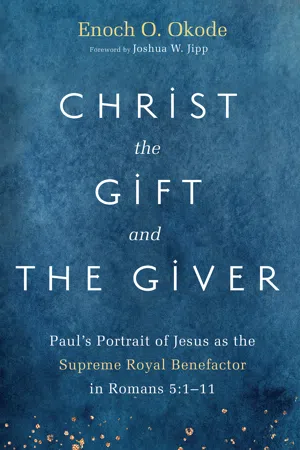![]()
1
Introduction and Methodology
Paul and Royal Christology in Romans 5:1–11
Recent arguments have suggested that one of the main threads of Paul’s Christ-language is royal discourse. This discourse is inspired by Paul’s conviction that Jesus is Israel’s Messiah and that, by his descent and ascent, he has been publicly revealed as the singular king of both Israel and the world. In his letter to the Romans, Paul introduces Jesus Christ as a descendant of David and as one who has been installed as the son-of-God-in-power by the resurrection from the dead (Rom 1:3–4). Jesus is not only the promised royal Messiah of David’s line but he has also been enthroned in power. He is the Lord (κύριος, 1:4, 7) who has entrusted his slave Paul with χάρις (“grace”) and apostleship, leading to the obedience of the nations (1:5). This royal depiction of Jesus is also found towards the end of the letter, thus forming an inclusio for the body of the letter (1:1–7 with 15:7–13). In 15:12, Paul invokes Isaiah 11 to declare that Jesus Christ is the root of Jesse who comes as the ruler and the hope of the nations. Jesus is the hope of the destiny of Israel and the nations. His suffering and vindication demonstrate God’s faithfulness, whereby God grants him sovereignty over the universe. The christological inclusio of Rom 1:1–7 and 15:7–13 shows Paul’s deliberate portrayal of Jesus as the royal Messiah and thereby suggests the intriguing possibility, and perhaps even the likelihood, that the body of Romans also contains messianic discourse.
And indeed some have argued convincingly that the body of Romans is also permeated with royal motifs, language, and concepts. Unlike Adam’s dominion, which is characterized by disobedience, sin, and death, Christ’s dominion is characterized by obedience, righteousness, and life (5:12–21). His crucifixion is the means by which he conquers sin and death (6:9–10) and secures liberation for humanity (6:11–14). The Messiah alone can rescue humanity “from the body of death” (τοῦ σώματος τοῦ θανάτου, 7:24). Jesus Christ is God’s son who identifies with humanity to secure their redemption (8:1–4). God delivers him up to death (8:32); and, because death could not hold him, he is now enthroned at God’s right hand (8:34). His victory over suffering, sin, and death guarantees the victory of his followers (8:37; cf. 8:17). Thus Paul’s royal ideology is programmatic for his messianic discourse in Romans 5–8 and in the entire letter.
We may then ask: Is royal Christology present within Paul’s discourse in Rom 5:1–11? Romans 5:1–11 has rightly been viewed as a summary of Paul’s preceding argument (1:1—4:25) and a thesis for what follows (5:12—8:39). The argument in these verses is framed by the prepositional phrase “through our Lord Jesus the Messiah” (διὰ τοῦ κυρίου ἡμῶν Ἰησοῦ Χριστοῦ) in 5:1 and 5:11. This framing replicates the same pattern as Paul’s christological inclusio for the whole letter (1:1–7 with 15:7–13). Therefore, if Paul is deliberately presenting Jesus as the Davidic Messiah whose eschatological reign incorporates Jews and gentiles, then we might expect the same intention to be prominent in this key passage. This study proposes that Paul’s christological discourse in 5:1–11, which he then expands upon in 5:12—8:39, makes better sense when interpreted through the framework of royal benefaction. That is to say, Paul depicts Christ as a royal benefactor whose superior gift delivers, empowers, and sustains his followers. Greco-Roman benefaction may be defined as a system of calculated gift exchange that seeks to enhance social cohesion by the ethic of reciprocity. Seneca states that gift-giving and its rules “constitutes the chief bond of human society” (Ben. 1.4.2–4). Aristotle maintains that wealth must be put to work in the form of beneficence, the doing of good (ἡ εὐεργεσία), and that such beneficence may include the preservation and means of life, the bestowal of wealth itself, or providing anything good which may be hard to obtain (Rhet. 1.5.7–9). He discusses two forms of benefaction in ancient Greece. The first is the noble individual who provides important benefits for the community as a whole (also known as collective benefaction or euergetism), and the second is the one who exchanges goods and services on an individual level with others who are equals, or nearly so, in status (Eth. nic. 4.2.5; 4.3.1). We are mainly concerned with the former, with focus on royal benefaction.
The ideal king is a generous benefactor who is committed to the welfare of his subjects. Julien Smith states that “the Hellenistic monarch’s efforts to cast himself as the benefactor of his people was largely successful to the extent that the ideal king came to be viewed as the source of a city’s benefits.” Dio Chrysostom writes that the good king receives his scepter from Zeus and finds great pleasure in using it for the welfare of his subjects (1 Regn.12–13). Such a king delights in bestowing benefits (2 Regn. 26) and governs as a father, with kindness, affection, and protective care (Hom. 53:12). Pliny notes in Panegyricus for Trajan that the ideal emperor is not necessarily an efficient administrator, but a benefactor and paternal protector (e.g., 2, 21, 28–31, 50). The good king toils endlessly for the sake of his subjects (Pliny, Pan. 7). Augustus’s Res Gestae recounts his benefactions and services to the Roman people as the emperor portrays himself as a generous benefactor and an effective agent of the Pax Romana. Horace praises Augustus’s guardianship which has restored plentiful harvests to the fields and eradicated civil war,...
